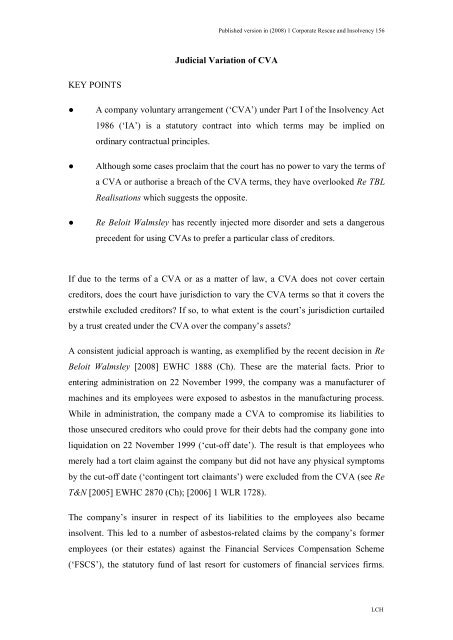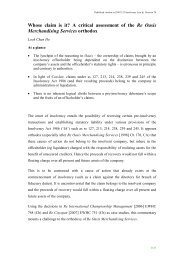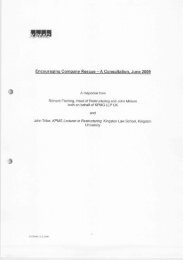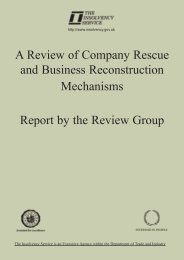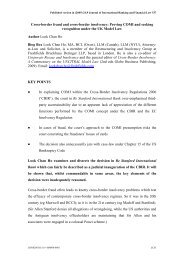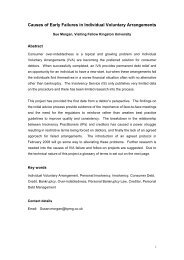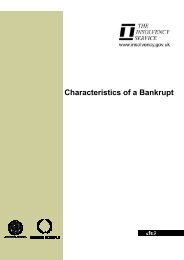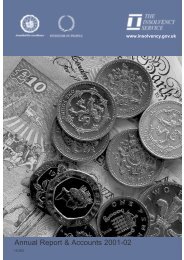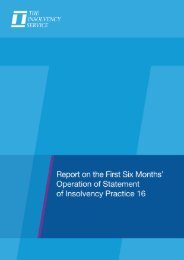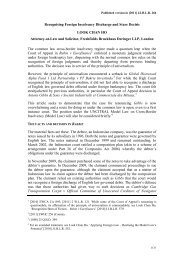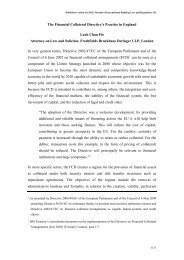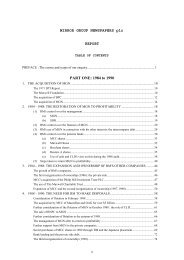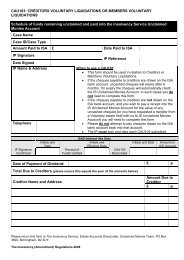Judicial variation of CVA - The Insolvency Service Website
Judicial variation of CVA - The Insolvency Service Website
Judicial variation of CVA - The Insolvency Service Website
Create successful ePaper yourself
Turn your PDF publications into a flip-book with our unique Google optimized e-Paper software.
Published version in (2008) 1 Corporate Rescue and <strong>Insolvency</strong> 156<strong>Judicial</strong> Variation <strong>of</strong> <strong>CVA</strong>KEY POINTSA company voluntary arrangement (‘<strong>CVA</strong>’) under Part I <strong>of</strong> the <strong>Insolvency</strong> Act1986 (‘IA’) is a statutory contract into which terms may be implied onordinary contractual principles.Although some cases proclaim that the court has no power to vary the terms <strong>of</strong>a <strong>CVA</strong> or authorise a breach <strong>of</strong> the <strong>CVA</strong> terms, they have overlooked Re TBLRealisations which suggests the opposite.Re Beloit Walmsley has recently injected more disorder and sets a dangerousprecedent for using <strong>CVA</strong>s to prefer a particular class <strong>of</strong> creditors.If due to the terms <strong>of</strong> a <strong>CVA</strong> or as a matter <strong>of</strong> law, a <strong>CVA</strong> does not cover certaincreditors, does the court have jurisdiction to vary the <strong>CVA</strong> terms so that it covers theerstwhile excluded creditors? If so, to what extent is the court’s jurisdiction curtailedby a trust created under the <strong>CVA</strong> over the company’s assets?A consistent judicial approach is wanting, as exemplified by the recent decision in ReBeloit Walmsley [2008] EWHC 1888 (Ch). <strong>The</strong>se are the material facts. Prior toentering administration on 22 November 1999, the company was a manufacturer <strong>of</strong>machines and its employees were exposed to asbestos in the manufacturing process.While in administration, the company made a <strong>CVA</strong> to compromise its liabilities tothose unsecured creditors who could prove for their debts had the company gone intoliquidation on 22 November 1999 (‘cut-<strong>of</strong>f date’). <strong>The</strong> result is that employees whomerely had a tort claim against the company but did not have any physical symptomsby the cut-<strong>of</strong>f date (‘contingent tort claimants’) were excluded from the <strong>CVA</strong> (see ReT&N [2005] EWHC 2870 (Ch); [2006] 1 WLR 1728).<strong>The</strong> company’s insurer in respect <strong>of</strong> its liabilities to the employees also becameinsolvent. This led to a number <strong>of</strong> asbestos-related claims by the company’s formeremployees (or their estates) against the Financial <strong>Service</strong>s Compensation Scheme(‘FSCS’), the statutory fund <strong>of</strong> last resort for customers <strong>of</strong> financial services firms.LCH
Published version in (2008) 1 Corporate Rescue and <strong>Insolvency</strong> 156After paying the claims, FSCS took an assignment <strong>of</strong> the rights <strong>of</strong> the employees (ortheir estates) against the company.<strong>The</strong> administrators <strong>of</strong> the company, who were also the <strong>CVA</strong> supervisors, applied forcourt directions in order to distribute funds in their hands, qua administrators orsupervisors, exclusively to creditors covered by the <strong>CVA</strong>, notwithstanding that therecould be contingent creditors (such as the contingent tort claimants) who were notcovered by the <strong>CVA</strong>. FSCS opposed the application and sought relief under s 6 <strong>of</strong> IAbecause the administrators’ position would preclude FSCS from recovering anythingin respect <strong>of</strong> claims assigned to it by the contingent tort claimants. FSCS requested adirection that the administrators or <strong>CVA</strong> supervisors reserve funds for the benefit <strong>of</strong>the contingent tort claimants.<strong>The</strong> court ruled against FSCS, reasoning thus:(a) as a matter <strong>of</strong> construction, the <strong>CVA</strong> excluded the contingent tort claimants;(b) the court had no power to vary the terms <strong>of</strong> the <strong>CVA</strong>, to sanction a course <strong>of</strong>action that involved a breach <strong>of</strong> the <strong>CVA</strong> terms, or to authorise the <strong>CVA</strong> supervisorsto proceed in a manner that had the effect <strong>of</strong> varying the <strong>CVA</strong> terms in a way thatinvolved a breach <strong>of</strong> trust created under the <strong>CVA</strong>;(c) as a matter <strong>of</strong> construction, all proceeds <strong>of</strong> realisations held by the administratorswere subject to a trust created under the <strong>CVA</strong>. Accordingly the court could not directthe administrators to breach the trust; and(d) FSCS’s application under s 6 <strong>of</strong> IA was time-barred and the court could not tollthe time bar. In any case, the court would be disinclined to grant any relief under s 6.Jurisdiction to vary <strong>CVA</strong> termsTo begin with, a <strong>CVA</strong> is a ‘statutory contract’ – a shorthand reference to the statutoryhypothesis whereby the arrangement is treated as if it were a consensual agreementbetween the debtor and all the relevant creditors such that dissenting creditors will bebound by the terms <strong>of</strong> the arrangement even if they have not agreed to its terms:Page 2
Published version in (2008) 1 Corporate Rescue and <strong>Insolvency</strong> 156Johnson v Davies [1999] 1 Ch 117, 138; Re Hellard and Goldfarb [2007] BPIR 1322at [3].Re Alpa Lighting [1997] BPIR 341 and Beloit Walmsley maintain that the court has nostatutory power to amend the statutory contract. But this proposition seemingly leavesthe case <strong>of</strong> Re FMS Financial Management <strong>Service</strong>s (1988) 5 BCC 191 hard tosquare. In FMS the debtor acting as a securities dealer induced its clients bymisrepresentation to purchase some worthless shares. After the debtor went intoadministration, due to disorderly records, the administrators managed to locate sharecertificates for some clients only. Clients who did not get their share certificates had aclaim for the return <strong>of</strong> their money, so a <strong>CVA</strong> was effected to cover these clients. Thisproduced an unfair result because, although all the clients bought the same worthlessshares in the same circumstances, only some clients could participate in the <strong>CVA</strong>.Participation in the <strong>CVA</strong> was thus purely fortuitous. In order to remedy thisunfairness, H<strong>of</strong>fmann J directed the administrators to admit claims from clients whohad received share certificates as if they were subject to the <strong>CVA</strong>. However, the effect<strong>of</strong> this direction was that creditors who would otherwise have been outside the <strong>CVA</strong>were brought into the <strong>CVA</strong>, causing the existing <strong>CVA</strong> creditors to recover much lessdividend from the <strong>CVA</strong>. As Evans-Lombe J said at first instance in Alpa Lighting,‘what the judge directed did involve what was in effect a <strong>variation</strong> <strong>of</strong> the [<strong>CVA</strong>]’([1997] BPIR 341, 343).Subsequent courts have tried different ways to compartmentalise FMS with politesse,including distinguishing it (e.g. Alpa Lighting), confining it to its own facts (e.g.Beloit Walmsley at [21]), questioning its precedential value because <strong>of</strong> its briefreasoning (e.g. Beloit Walmsley at [19]-[21]), and explaining it away in these terms:‘what is effectively a <strong>variation</strong> may be brought about, provided that it is not an actual<strong>variation</strong> <strong>of</strong> the approved proposal’: Hellard and Goldfarb at [19]. One textbookboldly suggests that FMS has been impliedly overruled: E Bailey and H Groves,Corporate <strong>Insolvency</strong>: Law and Practice (3rd edn, 2007), p 316.All the above compartmentalisations <strong>of</strong> FMS are unconvincing. <strong>The</strong> court direction inFMS should be viewed as implying a term into the <strong>CVA</strong> on the basis <strong>of</strong> businessefficacy. <strong>The</strong> court may read terms into a <strong>CVA</strong> on normal contractual principles inPage 3
Published version in (2008) 1 Corporate Rescue and <strong>Insolvency</strong> 156order to give the <strong>CVA</strong> business efficacy: Johnson v Davies at 128; Re Broome [1999]1 BCLC 356, 362. <strong>The</strong>re were ample business-efficacy grounds to justify theimplication <strong>of</strong> <strong>CVA</strong> terms in FMS. <strong>The</strong> fortuitous exclusion <strong>of</strong> certain creditors wasunquestionably unfair. As H<strong>of</strong>fmann J pointed out, there was no moral divide betweenthe creditors with share certificates and those without. Furthermore, absent courtdirection, the administrators could not safely distribute the assets to the <strong>CVA</strong> creditorsbecause the excluded creditors had misrepresentation claims against the debtor. ‘Itwould be a matter <strong>of</strong> reproach if any [excluded creditor] were to make a claim only t<strong>of</strong>ind that the court had authorised distribution <strong>of</strong> all the assets without leavinganything for him’ ((1988) 5 BCC 191, 193). Thus the actual direction given wasplainly sensible and amply justifiable.In sum, the above authorities proclaim that, while the court may imply terms into a<strong>CVA</strong> using normal contractual rules, it has no jurisdiction to vary the statutorycontract. How this proclamation sits with the Court <strong>of</strong> Appeal decision in Re TBLRealisations [2004] BCC 81 will be explored below.Jurisdiction to sanction a breach <strong>of</strong> <strong>CVA</strong> trustAccording to Beloit Walmsley, the court has no power to authorise a course <strong>of</strong> actionthat entails a breach <strong>of</strong> trust created under the <strong>CVA</strong>. But this appears to repudiate theCourt <strong>of</strong> Appeal decision in TBL Realisations. Extensive criticisms <strong>of</strong> TBLRealisations have been voiced elsewhere (see L C Ho and R J Mokal, ‘Interplay <strong>of</strong><strong>CVA</strong>, administration and liquidation: Part I’ (2004) 25 Company Lawyer 3; R JMokal, ‘Interplay <strong>of</strong> Administration, Liquidation, and <strong>CVA</strong>: Part II’ (2004) 25Company Lawyer 35).For present purposes, a short summary <strong>of</strong> the salient features in TBL Realisations isneeded. A bank, while facing a substantial tort claim by members <strong>of</strong> the Greenbergfamily (‘Greenbergs’), went into administration. Its administrators proposed a <strong>CVA</strong>.At the <strong>CVA</strong> meeting, the chairman rejected the Greenbergs’ claim for votingpurposes, thereby excluding the Greenbergs from the <strong>CVA</strong>. <strong>The</strong> Greenbergs thenobtained an injunction requiring the administrators to retain an amount up to the fullvalue <strong>of</strong> their claim outside <strong>of</strong> the <strong>CVA</strong>. Subsequently, the administrators soughtPage 4
Published version in (2008) 1 Corporate Rescue and <strong>Insolvency</strong> 156court direction as to the basis upon which the Greenbergs ought to be paid, arguingthat the Greenbergs should be paid pari passu with the <strong>CVA</strong> creditors. <strong>The</strong>Greenbergs argued that they should be paid the full amount <strong>of</strong> the judgment they hadobtained. But the court accepted the administrators’ contention.Recall the injunction the Greenbergs obtained requiring the administrators to keepmonies out <strong>of</strong> the <strong>CVA</strong>. <strong>The</strong> first instance court said it could grant the injunctionbecause the <strong>CVA</strong> created a trust only over assets already paid into the <strong>CVA</strong> account.Once paid into the <strong>CVA</strong> account, the assets could not be used to pay non-<strong>CVA</strong>creditors and the court had no power to direct a distribution in breach <strong>of</strong> trust. Prior tobeing paid into the <strong>CVA</strong> account, the bank’s assets were not subject to any trust.Accordingly the court should grant the injunction in order to protect the non-<strong>CVA</strong>creditors such as the Greenbergs ([2004] BCC 81, 88-89).However, on the subsequent substantive appeal, Chadwick LJ suggested in obiter that,despite the first instance court’s view, because the <strong>CVA</strong> required all the bank’s assetsto be realised by the administrators and paid to the <strong>CVA</strong> supervisors, all the bank’sassets were subject to a <strong>CVA</strong> trust. His Lordship went on to say it was unnecessary todecide this trust point ([2004] BCC 81, 105-106).Why was it unnecessary to decide the trust point? <strong>The</strong> answer is illuminating. If allthe bank’s assets were indeed subject to a <strong>CVA</strong> trust for the <strong>CVA</strong> creditors evenbefore they reached the <strong>CVA</strong> supervisors, two consequences would follow. First, theinjunction issued by the first instance judge would have amounted to a breach <strong>of</strong> trust.But the Court <strong>of</strong> Appeal did not question the propriety <strong>of</strong> the injunction. Second,ordering the Greenbergs to be paid out <strong>of</strong> funds retained outside the <strong>CVA</strong> would alsoamount to a breach <strong>of</strong> trust. <strong>The</strong>refore, the logical reason for the Court <strong>of</strong> Appeal’srefusal to decide the trust point must be that, at any rate, the court could authorise abreach <strong>of</strong> the <strong>CVA</strong> trust. If the court could authorise a breach <strong>of</strong> the <strong>CVA</strong> trustanyhow, the scope <strong>of</strong> the <strong>CVA</strong> trust would not matter. Hence there was no need todecide the trust point.It follows from the Court <strong>of</strong> Appeal’s reasoning that the first instance judge’sreasoning about the court’s inability to authorise a breach <strong>of</strong> trust must be a mistake.Page 5
Published version in (2008) 1 Corporate Rescue and <strong>Insolvency</strong> 156However, in concluding that it could not direct the <strong>CVA</strong> supervisors to breach the<strong>CVA</strong> trust, the court in Beloit Walmsley expressly relied on the reasoning <strong>of</strong> the firstinstance judge in TBL Realisations that the court could not authorise a breach <strong>of</strong> trust([2008] EWHC 1888 (Ch) at [22]). <strong>The</strong> implications <strong>of</strong> Chadwick LJ’s refusal todecide the trust point appear to have been entirely overlooked.One has to conclude that the authorities are irreconcilable. This irreconcilability hasextensive ramifications beyond the trust issue. If the court does indeed have power tosanction a breach <strong>of</strong> trust whose terms are governed by the <strong>CVA</strong>, the court musttherefore have power to sanction a breach <strong>of</strong> other <strong>CVA</strong> terms. If the court mayauthorise a breach <strong>of</strong> the <strong>CVA</strong> terms, it will no longer make sense to say the courtmay not vary the <strong>CVA</strong> terms. <strong>The</strong> court’s failure in Beloit Walmsley to appreciate thefull implications <strong>of</strong> TBL Realisations only adds instability to uncertainty.Exclusion <strong>of</strong> creditors from <strong>CVA</strong>If correct, Beloit Walmsley sets a disturbing precedent. <strong>CVA</strong>s may be drafted tosubject all the debtor’s assets to a trust for the benefit <strong>of</strong> certain creditors only, leavingall other creditors high and dry. Furthermore these excluded creditors would not havestanding to challenge the <strong>CVA</strong> under s 6 <strong>of</strong> IA. It cannot be right that <strong>CVA</strong>s could beused in such a discriminatory and expropriatory manner. But, as demonstrated inBeloit Walmsley, Part I <strong>of</strong> IA does not appear to provide any redress to theseexcluded, hapless creditors.It is suggested that there are a number <strong>of</strong> remedies potentially available to theexcluded creditors. First, if the discriminatory <strong>CVA</strong> is put in place without parallelinsolvency proceedings, the excluded creditors could seek to wind up the debtor.Upon liquidation, the <strong>CVA</strong> may be reversed as an unlawful preference under section239 <strong>of</strong> IA.Second, the court could interpret the <strong>CVA</strong> terms strictly against the preferred creditorsand liberally in favour <strong>of</strong> the excluded creditors.Page 6
Published version in (2008) 1 Corporate Rescue and <strong>Insolvency</strong> 156Third, the court could imply terms into the <strong>CVA</strong> on usual contractual principles. Asmentioned above, FMS should be seen as a case <strong>of</strong> implied terms with a view toavoiding injustice and promoting business efficacy.Fourth, if the discriminatory <strong>CVA</strong> is conducted within the administration framework,the excluded creditors could challenge the administrators’ conduct on the basis that itconstituted misfeasance (para 75 <strong>of</strong> Schedule B1 to IA) or unfairly harmed theexcluded creditors’ interests (para 74 <strong>of</strong> Schedule B1). In Beloit Walmsley, thepropriety <strong>of</strong> the administrators’ conduct was probably not an issue because thecontingent tort claimants were excluded from the <strong>CVA</strong> only by virtue <strong>of</strong> a legislativequirk which was probably unknown at the time <strong>of</strong> the <strong>CVA</strong>.Fifth, since the administrators’ statutory powers to promote a <strong>CVA</strong> are for the benefit<strong>of</strong> all creditors, promoting a discriminatory <strong>CVA</strong> is an unauthorised use <strong>of</strong> theirpowers. Any purported exercise <strong>of</strong> a power beyond the scope <strong>of</strong> the power isexcessive and void: Geraint Thomas, Thomas on Powers (1998), ch 8. Thus adiscriminatory <strong>CVA</strong> may be held to be void.Sixth, whenever possible, the court could issue an injunction to prevent the debtor’sassets from being caught by the <strong>CVA</strong> trust. Although this possibility does not appearto have been canvassed in Beloit Walmsley, this case in fact provides an apt factpatternto explore this remedy. Let us assume the court was correct as a matter <strong>of</strong>construction that, as soon as the company’s assets were realised by the administrators,the proceeds <strong>of</strong> realisations would be immediately subject to a trust. <strong>The</strong> <strong>CVA</strong> alsoprovided that all unrealised assets were excluded from the <strong>CVA</strong>, although theadministrators were under a duty to realise the unrealised assets. Conceivably thecourt could issue an injunction to prevent the administrators from realising theunrealised assets, thereby keeping those assets out <strong>of</strong> the <strong>CVA</strong> trust. In granting suchan injunction in TBL Realisations, the first instance judge said this:‘If a non-<strong>CVA</strong> Creditor is to be paid, it will be necessary to retain sufficientmonies outside the <strong>CVA</strong>. In principle, it seems … right that the court shouldgrant an injunction to ensure that this is done: otherwise the claims <strong>of</strong> acreditor excluded from the <strong>CVA</strong> would be rendered worthless. This mayPage 7
Published version in (2008) 1 Corporate Rescue and <strong>Insolvency</strong> 156arguably require the [administrators] to breach … the <strong>CVA</strong> under which theyagreed to pass realized funds … to the <strong>CVA</strong> Account. However … if thatagreement is not on its true construction subject to a right <strong>of</strong> retention to meetthe legitimate claims <strong>of</strong> non-<strong>CVA</strong> creditors, it should not have been givenwithout such a qualification, and in consequence does not <strong>of</strong> itself provide areason why the court should not impose the retention by prohibitive order’([2004] BCC 81, 88-89).Once kept out <strong>of</strong> the <strong>CVA</strong> trust, the unrealised assets could be distributed to thecontingent tort claimants represented by FSCS. <strong>The</strong> actual outcome in TBLRealisations demonstrates that assets retained outside a <strong>CVA</strong> can be distributed tocreditors outside the <strong>CVA</strong>.Conclusion<strong>The</strong> disarrayed state <strong>of</strong> the authorities does not lend itself to easy extraction <strong>of</strong> legalpropositions. One may say with confidence only that a <strong>CVA</strong> is a statutory contractthat is susceptible to implication <strong>of</strong> terms on ordinary contractual principles.Attempting unqualified legal propositions beyond that will attract discordance.<strong>The</strong> discordant hodgepodge <strong>of</strong> authorities find their embodiment in Beloit Walmsley.It says the court has no power to sanction a breach <strong>of</strong> <strong>CVA</strong> trust, but it relies on thereasoning <strong>of</strong> the first instance judgment in TBL Realisations that has been doubted onappeal. It says the court cannot authorise a breach <strong>of</strong> the <strong>CVA</strong> agreement, but theinjunction in TBL Realisations did just that. It says the court is unable to vary the<strong>CVA</strong> terms, but this makes no sense as long as TBL Realisations stands.On another front, Beloit Walmsley embodies a disturbing precedent enabling aninsolvent debtor’s assets to be used to prefer a particular class <strong>of</strong> creditors at theexpense <strong>of</strong> all other creditors. <strong>CVA</strong>s may be drafted to subject all the debtor’s assetsto a trust for the benefit <strong>of</strong> certain creditors only, leaving behind everyone else.Should such <strong>CVA</strong>s come to pass, the court should strive hard to arrest the injustice <strong>of</strong>expropriation.Page 8
Published version in (2008) 1 Corporate Rescue and <strong>Insolvency</strong> 156Look Chan Ho, MA, BCL (Oxon), LLM (Cantab), LLM (NYU), Attorney-at-Law andSolicitor, is a member <strong>of</strong> the Restructuring and <strong>Insolvency</strong> Group at FreshfieldsBruckhaus Deringer LLP, based in London. Email: lookchan.ho@freshfields.com. Ihave benefited from discussions with Pr<strong>of</strong>essor Riz Mokal and am most grateful toJackie Donner for her helpful comments. All views expressed herein are my soleresponsibility.Page 9


